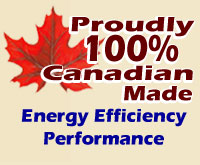



|
|
|
Becker EnergyGuard R-3000 windows can reduce your heating costs by hundreds of dollars a year! Learn first, how your old windows are losing heat energy, to better understand, how energy efficient windows perform and save money on energy bills.
It is a basic law of nature that heat energy will move from warmer areas to colder areas. In the context of windows, heat loss is the migration of heat energy from the interior of the building to the exterior through the different components of the window. It occurs in 4 different ways - radiation, conduction, convection and air leakage. We can find ways to slow these processes down. |
|

|
Radiation Radiation losses occur through the window glass and represent about 66% of the total heat loss in your old window. Regular glass transfers heat energy to colder surfaces. Heat travels through the air and glass in the form of infra-red and ultraviolet radiation. To prevent radiation heat loss, Becker EnergyGuard R-3000 feature high performance glazing system, including thermal edge spacer, maximum Argon Gas and ClimaGuard Double Low-E glass designed specificly to block infra-red and ultraviolet radiation. |
|
|

|
Conduction
Conduction losses in window occur primarily through the edges of the glazing and through the sash and frames. When warm inside air reaches the glass and frame of the window, heat energy is transferred molecule-to-molecule through the window material, gradually warming it up. When cold air from the outside touches the warm material, some heat is transferred to the air and carried away on the wind like hot coffe getting cooler when you blow on it. Becker EnergyGuard R-3000 windows minimize conduction by using double or triple paned glass in addition to Dessicant Filled Warm Edge Spacer and Thermally Broken Multichambered "Polyresin TRIO" uPVC Vinyl Frames and Sashes |
|
|

|
Convection
Convection losses occur due to air movement between the glazing layers of a window. It is simple physics, like warm air rises and cool air falls. This transfer of heat from the bottom of the window to the top of the window means the bottom of the window is constantly cooler and is therefore drawing more heat from the inside of the the house. The convection movement, or rising and falling of the air between the layers of glass, passes heat from the warm interior side to the cooler exterior side. To reduce convection heat loss Becker offers EnergyGuard R-3000 high performance glazing system, including thermal edge spacer, ClimaGuard Double Low-E glass and Maximum Argon Gas, which have a lesser tendency to expand when heated and therefore are less susceptible to convection. |
|
|

|
Air-Leakage
Air Leakage is a significant contributor to heat loss in windows. Installation plays a huge factor in air leakage. Poorly or carelessly installed windows with inadequate insulation and sealant between the outside perimeter of the frame and the rough opening will be a significant source of air leakage. Bad seals and cracked caulking allow air to pass between the window frame, the glass and the wall. Since warm air will always flow into a region with cooler air, windows that leak will allow warm air from inside the house to flow out and be lost. Becker Energy Star Windows are custom made to fit your existing window opening, build with triple of quadriple weatherstripping to prevent air draft. Installed with professional high quality materials, such as commercial grade caulking from inside and outside and enfironment friendly low expansion foam. |
| |



